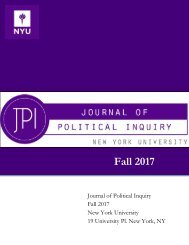JPI Spring 2018
Create successful ePaper yourself
Turn your PDF publications into a flip-book with our unique Google optimized e-Paper software.
Muslims as elites in urban centers, while most Christians remained peasants in the countryside. 22 The<br />
general Christian reaction to Ottoman conquest and dominance sparked the formation of cultural<br />
narratives that are inherently hostile to the Ottoman legacy. Mass conversion pushed Serbs and Croats<br />
to self-identify by religion and distance themselves from the ‘Turk’ designation, a derogatory term still<br />
used by nationalists that does not distinguish between Bosniaks and Ottomans. Conversion in the<br />
Ottoman Empire predominantly occurred in contact regions vulnerable to attacks from Christian<br />
Europe, specifically Bosnia and Albania. 23 In Bosnia, aside from forced victims of the devşirme child<br />
levy, conversions were voluntary. The jizya, or poll tax imposed on non-Muslims, incentivized the<br />
Ottoman administration to refrain from forced conversions. The tax became critical to driving<br />
revenues to maintain imperial operations. 24<br />
Historian Peter Sugar emphasizes that many scholars argue that economic benefits and<br />
improved social mobility motivated Slavs to convert to Islam. 25 However, he suggests that similarities<br />
among Christian and Islamic folk religions facilitated interaction, compromise, and the eventual<br />
creation of a mixed religion with elements of both traditions that led to conversions. 26 While Sugar<br />
seeks to dismiss the economic argument, it is evident that landowning elites converted to Islam,<br />
retaining their assets in exchange for loyalty to the Sultan. Perhaps economic benefits did not serve as<br />
an incentive to switch religions, but efforts to preserve status influenced the nobility. As Mazower<br />
writes, “For centuries, conversion and acculturation opened up elite careers to men of different<br />
backgrounds” before the Ottomans. 27 If conversion provided economic and class benefits before the<br />
Ottoman arrival, why wouldn’t nobles act similarly under the Ottomans? Ultimately, scholarship<br />
agrees that conversion and its legacy gave birth to Southeastern Europe’s greatest spark for conflict:<br />
“large areas inhabited by ethnically mixed populations.” 28<br />
FROM UNEASE TO UPRISING IN THE WESTERN BALKANS<br />
During the 19 th and 20 th centuries, the Ottoman Empire experienced increased unrest and<br />
uprising in its Balkan territories, specifically Bosnia, which lasted until its annexation by the Austro-<br />
Hungarian Empire in 1908. The Austrian influence further diversified the ethnic composition of towns<br />
like Višegrad: “At the same time officials began to arrive, civil servants with their families and, after<br />
them, artisans and craftsmen for all those trades which up till then had not existed in the town. Among<br />
them were Czechs, Poles, Croats, Hungarians, and Austrians.” 29 Mazower argues that the flow of<br />
Europeans into Eastern Bosnia brought ideas emanating from the French Revolution. These new<br />
Western concepts, like romantic nationalism, cultivated new ethno-religious state-building efforts in<br />
the Western Balkans that contributed to additional unrest. Mazower references centuries of relative<br />
ethnic peace in the Ottoman Balkans before the introduction of contemporary nationalism, arguing<br />
22<br />
Peter F. Sugar, Southeastern Europe under Ottoman Rule, 1354-1804, vol. 5 of A History of East Central Europe (Seattle: University of Washington Press,<br />
1977), 50-59.<br />
23<br />
L. Carl Brown, Imperial Legacy: The Ottoman Imprint on the Balkans and the Middle East (New York: Columbia University Press, 1997), 63.<br />
24<br />
Florian Bieber, "Muslim Identity in the Balkans before the Establishment of Nation States," Nationalities Papers 28, no. 1 (March 2000): 22, Historical<br />
Abstracts with Full Text, EBSCOhost (accessed November 20, 2017).<br />
25<br />
Peter F. Sugar, Southeastern Europe under Ottoman Rule, 1354-1804, vol. 5 of A History of East Central Europe (Seattle: University of Washington Press,<br />
1977), 50-59.<br />
26<br />
Florian Bieber, "Muslim Identity in the Balkans before the Establishment of Nation States," Nationalities Papers 28, no. 1 (March 2000): 22, Historical<br />
Abstracts with Full Text, EBSCOhost (accessed November 20, 2017).<br />
27<br />
Mark Mazower, The Balkans: A Short History (New York: Random House, Inc., 2000), 40.<br />
28<br />
Peter F. Sugar, Southeastern Europe under Ottoman Rule, 1354-1804, vol. 5 of A History of East Central Europe (Seattle: University of Washington Press,<br />
1977), 284.<br />
29<br />
Ivo Andrić, The Bridge on the Drina (Chicago: University of Chicago Press, 1977), 135.<br />
<strong>JPI</strong> Fall 2017, pg. 12
















